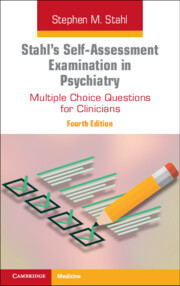Book contents
- Stahl’s Self-Assessment Examination in Psychiatry
- Stahl’s Self-Assessment Examination in Psychiatry
- Copyright page
- Contents
- Introduction/Preface
- CME/CE Information
- 1 ADHD and Its Treatment
- 2 Anxiety/Stress Disorders and Their Treatment
- 3 Basic Neuroscience and Pharmacological Concepts
- 4 Bipolar Disorder and Its Treatment
- 5 Chronic Neuropathic Pain and Its Treatment
- 6 Dementia and Its Treatment
- 7 Psychosis and Its Treatment
- 8 Sleep/Wake Disorders and Their Treatment
- 9 Substance Use/Impulsive-Compulsive Disorders and Their Treatment
- 10 Unipolar Depression and Its Treatment
- Index
- References
2 - Anxiety/Stress Disorders and Their Treatment
Published online by Cambridge University Press: 22 July 2022
- Stahl’s Self-Assessment Examination in Psychiatry
- Stahl’s Self-Assessment Examination in Psychiatry
- Copyright page
- Contents
- Introduction/Preface
- CME/CE Information
- 1 ADHD and Its Treatment
- 2 Anxiety/Stress Disorders and Their Treatment
- 3 Basic Neuroscience and Pharmacological Concepts
- 4 Bipolar Disorder and Its Treatment
- 5 Chronic Neuropathic Pain and Its Treatment
- 6 Dementia and Its Treatment
- 7 Psychosis and Its Treatment
- 8 Sleep/Wake Disorders and Their Treatment
- 9 Substance Use/Impulsive-Compulsive Disorders and Their Treatment
- 10 Unipolar Depression and Its Treatment
- Index
- References
Summary
A 35-year-old female presents to your office and begins to divulge her frequent worries: ever since she was young, she was worried someone close to her would die in a freak accident. As she grew older, this worry was exacerbated by the fear that she would pass away without telling her friends and family how important they are to her. Additionally, once she had children, she became so worried for their safety that she rarely lets them leave the house. Furthermore, she has constant worries about how things will work out for her in the future, and recently experienced a panic attack. Based only on what you know here, how might you currently diagnose this patient?
- Type
- Chapter
- Information
- Stahl's Self-Assessment Examination in PsychiatryMultiple Choice Questions for Clinicians, pp. 39 - 74Publisher: Cambridge University PressPrint publication year: 2022



